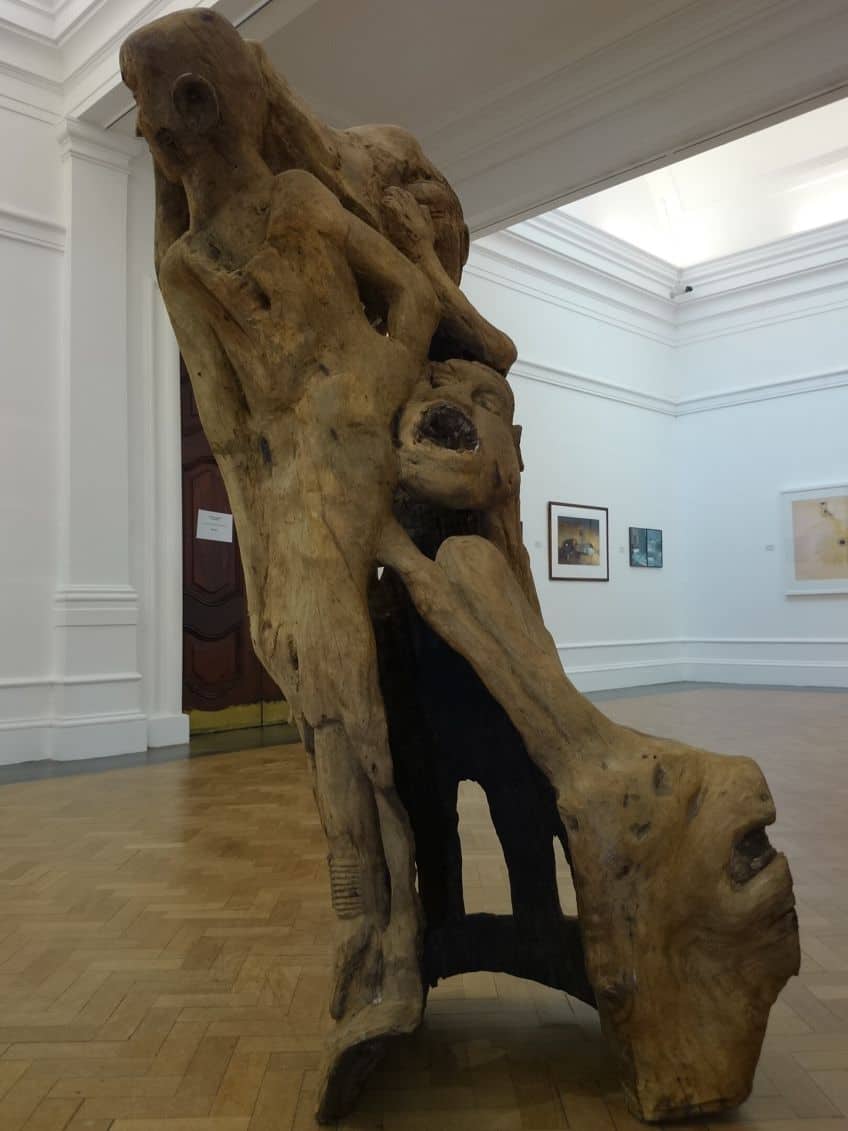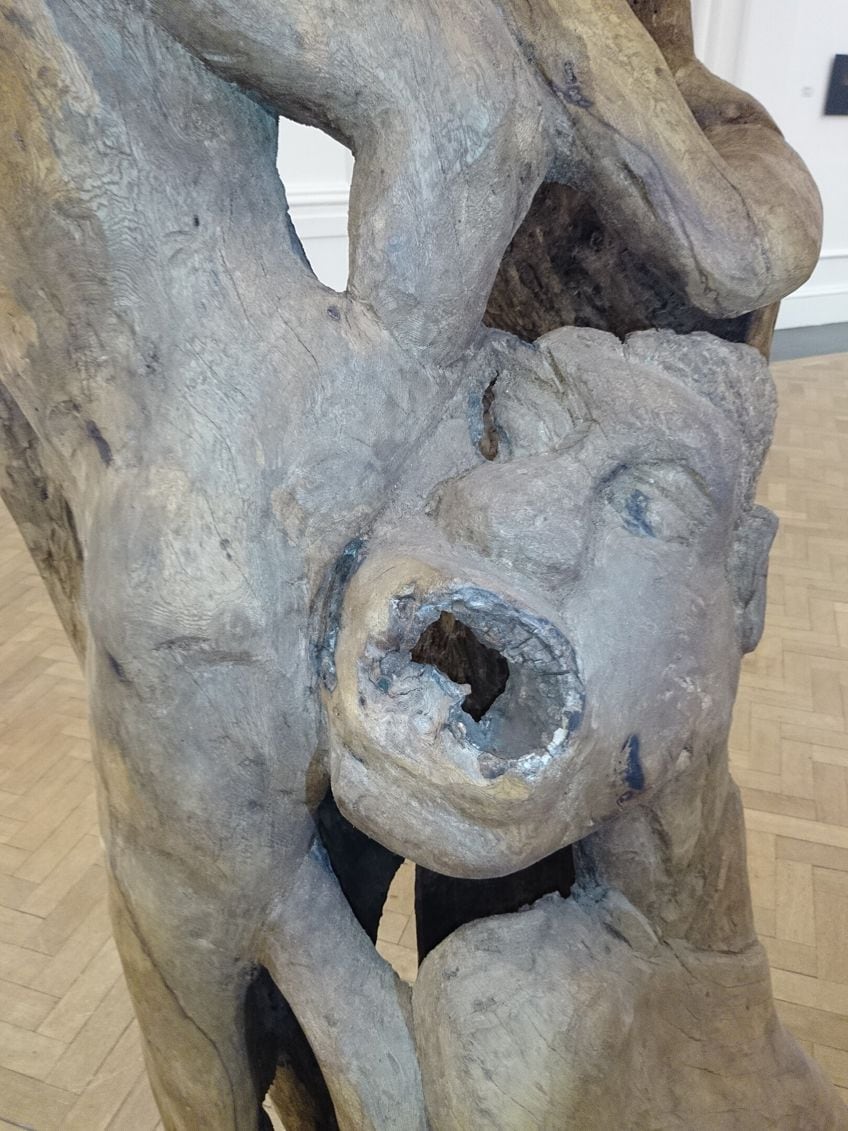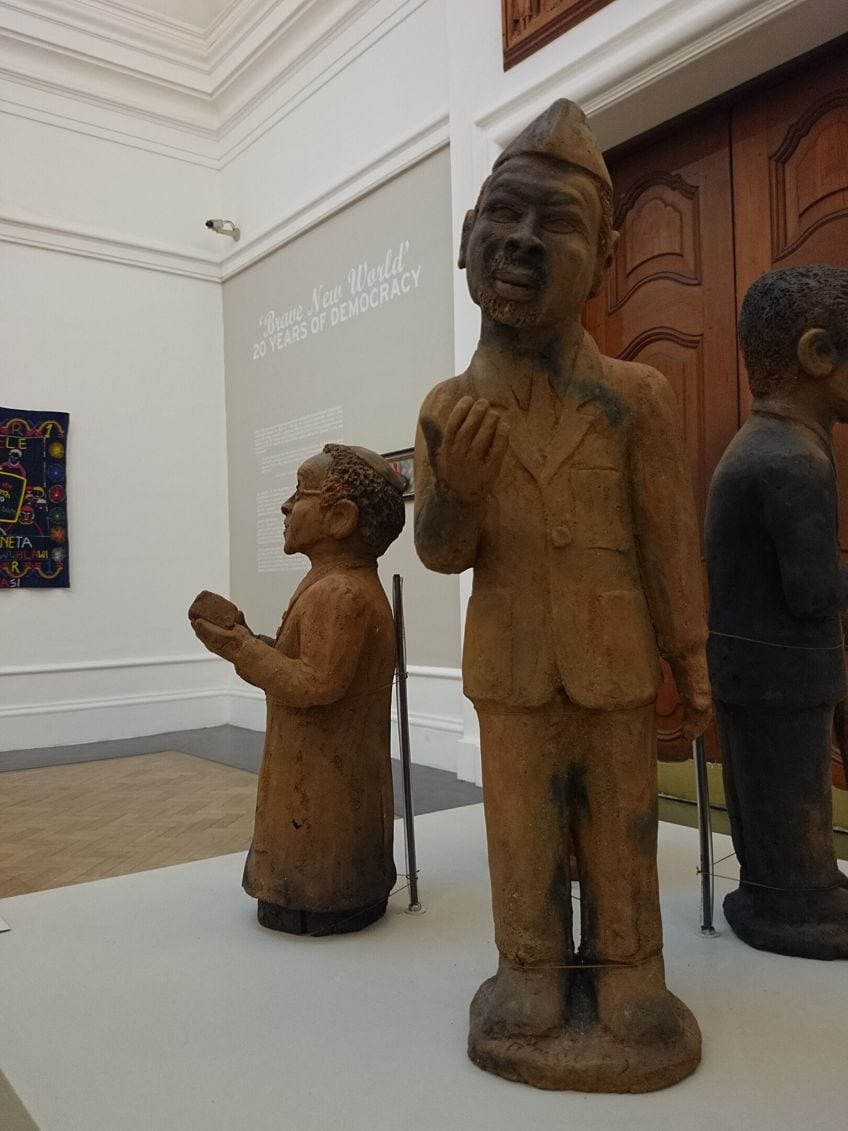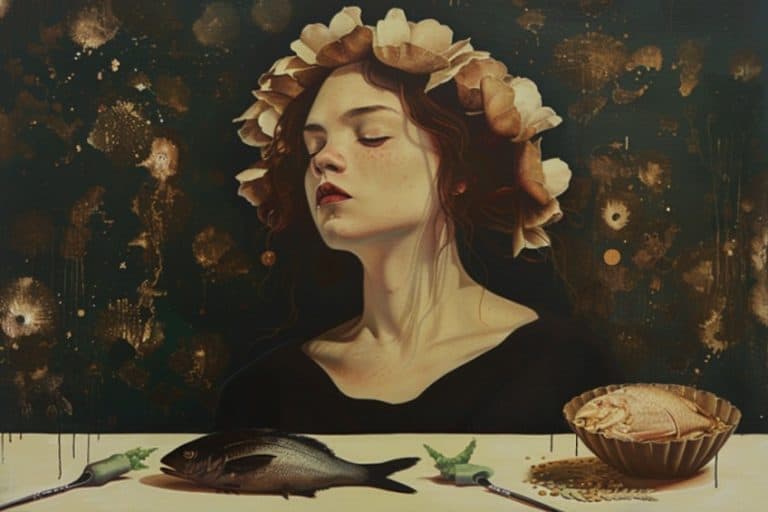Noria Mabasa – Discover This Famous South African Artist
Noria Mabasa, a famous South African artist, has carved her name into the annals of art history with her extraordinary talent and profound creativity. Renowned for her exquisite artworks, this gifted artist has captivated the world with her unique vision and deep-rooted connection to her cultural heritage. In this article, we will delve into her life and look at the importance of Noria Mabasa’s artworks, exploring the rich tapestry of her artistic journey and the remarkable pieces that have made her an iconic figure in the world of South African art.
Noria Mabasa Artist Abstract: A Famous South African Artist
| Date of Birth | 10 May 1938 |
| Age | 85 years old |
| Place of Birth | Shigalo or Xigalo, Limpopo, South Africa |
| Nationality | South African |
| Mediums | Ceramic and wood sculpture |
Noria Mabasa was born in 1938 in the rural village of Xigalo in Limpopo Province. Her early years were deeply rooted in the Venda culture, a foundation that would later become a profound source of inspiration for her artistic journey. Growing up in a community steeped in tradition, Mabasa developed a deep appreciation for the rituals, beliefs, and stories that shaped her people’s lives. This formative connection to her cultural heritage would become a driving force behind her extraordinary artistic creations.
Influences
Mabasa’s early life experiences and upbringing provided the bedrock for her artistic expression. She drew inspiration from the oral traditions and folklore of the Venda people, as well as the natural world that surrounded her in the lush landscapes of Limpopo.
Her art was deeply influenced by the spiritual and mystical elements of her culture, which she skillfully translated onto the canvas through her unique visual language.
Training and Early Artworks
Noria Mabasa’s artistic journey began in earnest in the 1980s when she first encountered the work of Jackson Hlungwani (1923 – 2010), another renowned South African artist. Hlungwani’s sculptures and wood carvings left an indelible impression on Mabasa and served as a catalyst for her own artistic pursuits. She began experimenting with wood and stone, initially carving utilitarian objects before venturing into the realm of sculpture. Her early works showcased her innate talent for imbuing life into inanimate materials, creating sculptures that resonated with cultural significance and spiritual depth.

Major Career Achievements
Over the years, Noria Mabasa’s artistic career has been marked by numerous accolades and achievements. Her works have been exhibited internationally, garnering attention and acclaim for their profound symbolism and cultural resonance. In 2002, she was awarded the Silver category of the Order of the Baobab, one of South Africa’s highest honors, for her outstanding contribution to the arts and her dedication to preserving Venda cultural heritage.
Mabasa’s art has also been featured in prestigious galleries and museums, solidifying her status as a prominent figure in the global art scene.
Influence on South African Art and Art History
Noria Mabasa’s influence on South African art extends far beyond her own creations. She stands as a trailblazer, breaking through cultural and gender barriers to establish herself as a formidable force in the art world. Her ability to merge traditional Venda aesthetics with contemporary artistic forms has not only enriched South African art but also challenged the boundaries of creative expression.
Mabasa’s work has inspired a new generation of South African artists to explore their cultural roots and create art deeply rooted in identity and heritage. Her legacy is a testament to the power of art in preserving and celebrating cultural traditions, making Noria Mabasa a revered figure in South African art history and an inspiration to artists worldwide.
Noria Mabasa’s Artworks: A Window into South Africa’s Socio-Political Landscape
Noria Mabasa stands as both a witness to and a commentator on the turbulent socio-political history of her homeland. Her artworks, characterized by their deep cultural resonance and poignant storytelling, provide a profound glimpse into the multifaceted layers of South Africa’s past and present. In this section of the article, we will contextualize Noria Mabasa’s artworks within the complex socio-political landscape of South Africa.
We explore how her creations serve as mirrors reflecting the nation’s struggles, resilience, and triumphs.
Apartheid Era and Its Impact
Noria Mabasa’s artistic journey unfolded against the backdrop of apartheid, a brutal system of racial segregation and oppression that gripped South Africa for decades. Born in 1938, Mabasa grew up in a rural village in Limpopo Province, experiencing firsthand the injustices and inequalities that defined apartheid. This deeply oppressive era left an indelible mark on her life and art, fueling her desire to tell the stories of her people and resist the dehumanization inflicted by apartheid policies.

A Voice of the Marginalized
Mabasa’s art extends beyond the personal to the collective experiences of marginalized communities in South Africa. Her sculptures often depict everyday people, their struggles, and their triumphs. She captures the essence of ordinary life amidst extraordinary circumstances, offering a voice to those who have historically been silenced and overlooked.
Her works become a collective memory of resilience, a testament to the human spirit’s ability to endure even in the face of adversity.
Humanizing the Powerful
While Mabasa’s art addresses the suffering and oppression of apartheid, it also offers a nuanced perspective on those who held power during that era. Her sculptures of South African policemen, for instance, depict not just the enforcers of apartheid but also their vulnerability and bafflement. Through this approach, Mabasa humanizes those who played a role in sustaining apartheid, challenging viewers to consider the complexities of individual choices within the larger system of oppression.

The Post-Apartheid Transition
Following the dismantling of apartheid in the early 1990s, South Africa underwent a profound transformation. Noria Mabasa’s art continued to evolve, reflecting the nation’s transition towards reconciliation, justice, and healing.
Her works began to explore themes of hope, unity, and the ongoing struggle for equality, embodying the spirit of a nation in transition.
Exploring the Technical Mastery of Noria Mabasa’s Artworks
Noria Mabasa is renowned not only for the profound cultural and spiritual depth of her creations but also for her remarkable technical prowess. Her artworks, primarily sculptural pieces, are a testament to her exceptional craftsmanship and her ability to breathe life into her chosen mediums. In this section of the article, we delve into the technical characteristics that make Noria Mabasa’s artworks a mesmerizing fusion of tradition, innovation, and artistic excellence.

Mediums and Materials
One of the most striking features of Noria Mabasa’s artworks is her mastery of various mediums and materials. Throughout her career, she has worked with wood, stone, clay, and bronze, each chosen for its unique properties and the cultural significance it holds. Wood, in particular, plays a prominent role in her oeuvre. Mabasa sources her materials locally, often selecting indigenous woods that carry a spiritual connection to her Venda heritage.
The choice of medium is never arbitrary; instead, it is deeply intertwined with the narrative and symbolism of each piece.
Carving Techniques
Mabasa’s sculptures are predominantly carved from wood, and her carving techniques are nothing short of awe-inspiring. She employs both traditional and innovative carving methods, using chisels, adzes, and other hand tools to shape the wood. The precision of her carving is evident in the intricate details of her pieces, from the delicate facial features to the flowing robes of her figures. Mabasa’s ability to transform rough, unyielding wood into graceful and emotive forms is a testament to her technical skill and artistic vision.

Symbolism and Narrative
Central to Noria Mabasa’s artworks is their rich symbolism and narrative depth. Each piece tells a story, often drawing from Venda folklore, rituals, and spirituality. Her sculptures are not merely static forms but living vessels of cultural meaning. Mabasa meticulously incorporates symbols, motifs, and iconography that convey the essence of her subjects, whether they are ancestral spirits, mythical creatures, or everyday people.
Her attention to detail in conveying these narratives through her carvings adds a layer of complexity and emotional resonance to her artworks.
Texture and Surface Finish
Texture is a defining characteristic of Mabasa’s sculptures. She often leaves the surface of her wood sculptures textured and rough, allowing the viewer to feel the history and energy of the material. The juxtaposition of smooth and rough textures creates a tactile experience that enhances the viewer’s connection to the artwork. In some pieces, Mabasa employs polishing techniques to achieve a smoother finish, highlighting specific elements of the sculpture and adding depth to the overall composition.

Scale and Proportion
Mabasa’s sculptures vary in scale, ranging from small, intimate pieces to larger-than-life installations. Her understanding of scale and proportion is a testament to her versatility as an artist. Whether crafting a diminutive figurine or a towering totem, Mabasa’s attention to the relationship between the artwork and its surroundings is evident.
This mastery of scale allows her to create art that resonates on a personal level or commands attention in a public space.
Color and Patina
While much of Mabasa’s work is in the natural tones of wood, she occasionally introduces color to her sculptures through the use of paints and dyes. These colors are carefully chosen to enhance the visual impact and cultural symbolism of the piece. In some instances, Mabasa employs patination techniques on her bronze sculptures to create unique surface effects, giving the metal an aged or weathered appearance that complements the narrative of the artwork.
Visual and Conceptual Analysis of South African Policemen (1987)
| Title | South African Policemen |
| Date | 1987 |
| Medium | Enamel paint and clay |
| Items | Two |
| Dimensions (cm) | 54 cm each |
| Location | N/A |
Noria Mabasa’s South African Policemen (1987) stands as a poignant embodiment of both visual and conceptual complexity within the realm of South African art. This striking artwork, crafted from enamel paint on fired clay, presents an archetypal pair of figures – black and white, representing the agents of apartheid, the enforcers of a discriminatory regime. Yet, Mabasa’s portrayal goes beyond a simple critique of power; it delves into a deeper, more profound exploration of humanity.
Visual Elements
The figures in South African Policemen are rendered in stark black and white, capturing the inherent duality and division of apartheid-era South Africa. The artist’s careful awareness of detail is apparent in their miniature scale, each element carefully crafted to convey a sense of upstanding rigor. The juxtaposition of their green uniforms against their diminutive size creates a visually striking and emotionally charged tableau. The figures themselves are rendered with a plainness that misrepresents the intricacy of the subject matter. Their postures are upright, suggesting authority, yet within this, there is an unmistakable sense of vulnerability. The use of enamel paint on fired clay allows for a textured surface, inviting the viewer to engage with the tactile qualities of the artwork.
This tactile engagement serves to humanize the figures, inviting empathy and a deeper exploration of their inner worlds.
Conceptual Depth
Beyond the immediate visual impact, Mabasa’s South African Policemen invites a profound conceptual analysis. These figures represent more than just servants of power; they encapsulate a striking sense of innocence and bafflement. Mabasa captures, with a gentle touch, the realization that power, as Michel Foucault jogs our memory, is always breakable and fortified.
Rather than overtly critiquing power, Mabasa’s work offers a more nuanced perspective. She does not make a declarative statement but instead provides a space for reflection and understanding. Through her portrayal, she humanizes these figures who were, in the broader context, agents of a repressive system. This humanization compels the viewer to consider the complex interplay of individual choices, societal pressures, and the broader historical context that shaped their actions.

Furthermore, the inherent bafflement in the faces of these figures challenges our assumptions about those who wield power. Mabasa’s ability to capture their vulnerability and uncertainty serves as a reminder that even within systems of oppression, individuals are not monolithic; they grapple with their own moral dilemmas and existential questions.
In the medley of South African artistry, Noria Mabasa’s contributions are nothing short of extraordinary. Noria Mabasa’s artworks, with their profound cultural resonance and technical mastery, have transcended mere creations to become windows into the rich tapestry of South Africa’s history and identity. As a famous South African artist, Mabasa’s work has not only preserved the traditions of her Venda heritage but has also challenged and expanded the boundaries of artistic expression. Through her direct, subtle, and gentle approach, she has provided us with an invaluable opportunity to engage with the complexities of power, humanity, and the enduring spirit of a nation. Noria Mabasa’s legacy is a testament to the transformative power of art, bridging cultures, histories, and hearts, and ensuring her place among the luminaries of the global art landscape.
Frequently Asked Questions
Where Does Noria Mabasa Get Her Material?
Noria Mabasa primarily sources her materials locally, often selecting indigenous woods that carry a deep cultural and spiritual significance to her Venda heritage. These materials become the foundation for her sculptures, allowing her to infuse them with both artistic vision and a profound connection to her cultural roots.
What Inspired Noria Mabasa?
Noria Mabasa draws inspiration from her upbringing in the rural village of Xigalo in the Limpopo province of South Africa. Her art is deeply influenced by the oral traditions, folklore, and natural surroundings of her Venda culture. Additionally, she was inspired by the work of fellow South African artist Jackson Hlungwani (1923 – 2010), whose sculptures ignited her artistic pursuits. Mabasa’s art is a reflection of her profound connection to her cultural heritage and the rich tapestry of stories, rituals, and beliefs that shaped her life.
What Makes Noria Mabasa’s Artworks So Important?
Noria Mabasa’s artworks are not merely aesthetic creations but powerful testimonies to South Africa’s socio-political history. They bear witness to the suffering, resilience, and enduring spirit of a nation marked by apartheid’s darkness and the promise of a brighter future. Mabasa’s ability to infuse her art with cultural heritage, resistance, and a commitment to humanizing all facets of society ensures that her work continues to be a source of reflection, inspiration, and social commentary in the ever-evolving landscape of South African society.
Nicolene Burger is a South African multi-media artist, working primarily in oil paint and performance art. She received her BA (Visual Arts) from Stellenbosch University in 2017. In 2018, Burger showed in Masan, South Korea as part of the Rhizome Artist Residency. She was selected to take part in the 2019 ICA Live Art Workshop, receiving training from art experts all around the world. In 2019 Burger opened her first solo exhibition of paintings titled, Painted Mantras, at GUS Gallery and facilitated a group collaboration project titled, Take Flight, selected to be part of Infecting the City Live Art Festival. At the moment, Nicolene is completing a practice-based master’s degree in Theatre and Performance at the University of Cape Town.
In 2020, Nicolene created a series of ZOOM performances with Lumkile Mzayiya called, Evoked?. These performances led her to create exclusive performances from her home in 2021 to accommodate the mid-pandemic audience. She also started focusing more on the sustainability of creative practices in the last 3 years and now offers creative coaching sessions to artists of all kinds. By sharing what she has learned from a 10-year practice, Burger hopes to relay more directly the sense of vulnerability with which she makes art and the core belief to her practice: Art is an immensely important and powerful bridge of communication that can offer understanding, healing and connection.
Nicolene writes our blog posts on art history with an emphasis on renowned artists and contemporary art. She also writes in the field of art industry. Her extensive artistic background and her studies in Fine and Studio Arts contribute to her expertise in the field.
Learn more about Nicolene Burger and the Art in Context Team.
Cite this Article
Nicolene, Burger, “Noria Mabasa – Discover This Famous South African Artist.” Art in Context. February 5, 2024. URL: https://artincontext.org/noria-mabasa/
Burger, N. (2024, 5 February). Noria Mabasa – Discover This Famous South African Artist. Art in Context. https://artincontext.org/noria-mabasa/
Burger, Nicolene. “Noria Mabasa – Discover This Famous South African Artist.” Art in Context, February 5, 2024. https://artincontext.org/noria-mabasa/.











